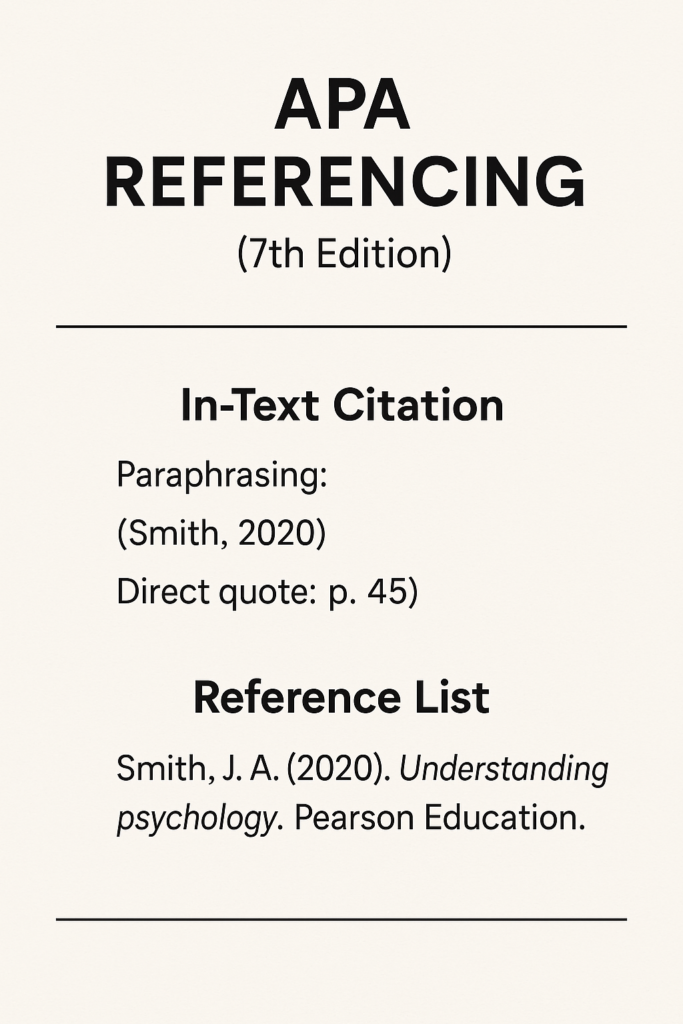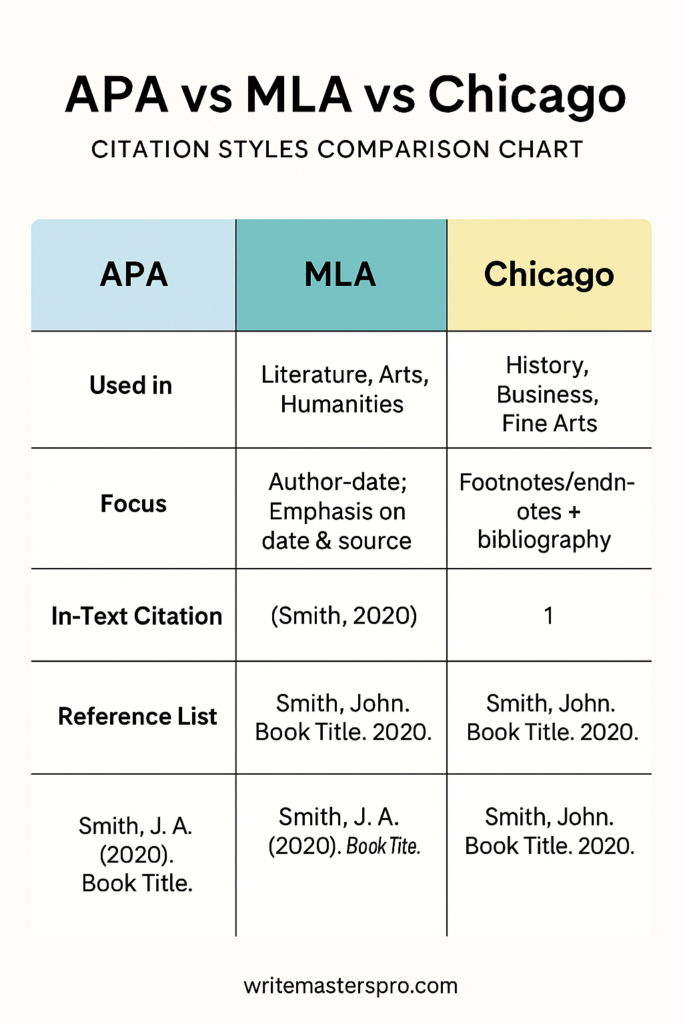Posted: May 13th, 2025
Mastering 3 Essential Academic Referencing Styles: Your Ultimate Guide to APA, MLA, and Chicago – 2025

- Intronduction
- Why Referencing Matters in Academic Writing
- Understanding the Three Major Referencing Styles
- APA Style (7th Edition) – American Psychological Association Explained
- MLA Style (9th Edition) – Modern Language Association
- Chicago Style (17th Edition) – University of Chicago Press
- Tips for Using Referencing Styles Correctly
- Common Referencing Mistakes to Avoid
- Which Citation Style Should You Use?
- Conclusion: Academic Referencing Doesn’t Have to Be Difficult
Intronduction
Academic writing is more than just good grammar and coherent structure—it’s about building credibility, showcasing research depth, and maintaining academic integrity. At the core of these principles lies accurate referencing. Whether you’re crafting a university essay, compiling a thesis, or working on a detailed research paper, citing your sources correctly is essential for avoiding plagiarism and boosting the quality of your academic work.
In this ultimate guide, we’ll walk you through the three most commonly used citation styles in higher education: APA, MLA, and Chicago. You’ll discover when to use each style, how to format citations, and see clear, practical examples that will help you cite with confidence.
This blog is a must-read for students, researchers, and academic professionals looking to improve their referencing skills and submit error-free assignments. So, if you’re aiming to write better academic papers or need reliable academic writing help, you’re in the right place.
Why Referencing Matters in Academic Writing
At WriteMastersPro.com, we emphasize the value of accurate academic referencing in every project. Whether you’re using APA, MLA, or Chicago style, citing your sources properly is more than just a formality—it’s essential to maintaining academic integrity and producing high-quality scholarly work.
Here’s why mastering citation styles is so important:
- Acknowledges Intellectual Ownership
Proper referencing gives credit to original thinkers and researchers. It’s how you ethically use ideas that are not your own, helping you avoid unintentional plagiarism. - Promotes Research Transparency
Accurate citations allow instructors, peers, and future researchers to trace your sources, verify your claims, and evaluate the strength of your arguments. - Boosts Credibility and Authority
When you reference credible sources, you enhance the trustworthiness of your paper. It shows that your writing is grounded in legitimate academic research. - Ensures Structural Consistency
Following a recognized citation style (like APA, MLA, or Chicago) ensures that your work is presented in a clear, organized, and professional format—an expectation at all academic levels.
Failing to cite your sources properly can result in serious academic consequences—from lower grades to disciplinary action. That’s why our academic writing experts at WriteMastersPro.com are here to provide comprehensive referencing and citation support, so you can write with confidence and academic integrity.
Understanding the Three Major Referencing Styles

Different academic disciplines favor different citation styles. Here’s a quick overview of when and where each of the big three is used:
| Style | Used in | Focus |
|---|---|---|
| APA | Psychology, Education, Social Sciences | Author-date; Emphasis on date & source |
| MLA | Literature, Arts, Humanities | Author-page; Emphasis on authorship |
| Chicago | History, Business, Fine Arts | Footnotes/endnotes + bibliography |
APA Style (7th Edition) – American Psychological Association Explained

When writing academic papers in the social sciences, psychology, education, or business, the APA Style (7th Edition) is widely accepted for formatting and citation. Understanding and applying this referencing style correctly is essential for students who want to present professional, credible, and plagiarism-free work. At WriteMastersPro.com, we help students master APA referencing to enhance their academic success.
What Is APA Style?
APA Style is a citation format developed by the American Psychological Association. It provides clear guidelines for formatting research papers, citing sources, and structuring content in an organized, reader-friendly way. The APA 7th edition updated many rules, making it more inclusive and easier to use.
Key Features of APA Style (7th Edition)
- Author-Date Citation System: APA uses in-text citations that include the author’s last name and the year of publication.
- Double-Spaced Text: All content, including references, should be double-spaced.
- Title Page Requirements: Student papers require a title, author name, institution, course, instructor, and due date.
- Running Head (Optional for Students): A running head is not required for student papers.
- Font Flexibility: Acceptable fonts include 12-point Times New Roman, 11-point Calibri, and 11-point Arial.
In-Text Citation Examples (APA 7th Edition)
- Paraphrasing: (Smith, 2020)
- Direct Quote: (Smith, 2020, p. 45)
If the source has two authors:
- (Smith & Johnson, 2021)
For three or more authors:
- (Smith et al., 2022)
Reference List Format
The reference list begins on a new page titled “References” and is arranged alphabetically by the authors’ last names. Each reference has a hanging indent.
Examples:
Book:
Smith, J. A. (2020). Understanding psychology. Pearson Education.
Journal Article:
Brown, L. T., & Green, D. R. (2019). Cognitive learning in digital environments. Journal of Educational Psychology, 111(2), 123–135. https://doi.org/10.1037/edu0000345
Website:
American Psychological Association. (2023). APA Style guidelines. https://apastyle.apa.org
Final Thoughts
Mastering APA referencing is essential for crafting polished, professional academic assignments. At WriteMastersPro.com, we assist students with APA-style writing to ensure accuracy and improve academic performance. Whether you’re writing essays, research papers, or dissertations, proper citation builds credibility and prevents plagiarism.
MLA Style (9th Edition) – Modern Language Association
When to Use MLA:
MLA is commonly used in the humanities, especially in literature, history, philosophy, and cultural studies. It focuses on the author’s contribution and the source’s location (page number).
MLA In-Text Citation Basics:
MLA uses the author-page format without commas.
Example:
According to Morrison, symbolism is central to her work (45).
OR
Symbolism is central to Morrison’s work (Morrison 45).
MLA Works Cited Format:
MLA uses a Works Cited page, with entries arranged alphabetically.
Book Example:
Morrison, Toni. Beloved. Vintage Books, 2004.
Journal Article Example:
Smith, John. “Digital Literacy and the Modern Learner.” Journal of Media Studies, vol. 22, no. 1, 2020, pp. 33–47.
Website Example:
“About Us.” The Art Institute of Chicago, www.artic.edu/about. Accessed 2 Jan. 2024.
Chicago Style (17th Edition) – University of Chicago Press
When to Use Chicago:
Chicago style is favored in history, business, and the fine arts. It provides two documentation systems:
- Notes and Bibliography (NB) – Common in humanities
- Author-Date – Used in social sciences (similar to APA)
We’ll focus on Notes and Bibliography, the more popular version.
Chicago In-Text Citation Basics:
Instead of in-text citations, Chicago uses footnotes or endnotes with superscript numbers that point to corresponding notes at the bottom of the page or end of the chapter.
Example in text:
The fall of the Roman Empire had many causes, including military and economic decline.¹
Footnote:
- Edward Gibbon, The History of the Decline and Fall of the Roman Empire (New York: Penguin Books, 1994), 67.
Chicago Bibliography Format:
The bibliography appears at the end, titled Bibliography. Entries are in alphabetical order and use a hanging indent.
Book Example:
Gibbon, Edward. The History of the Decline and Fall of the Roman Empire. New York: Penguin Books, 1994.
Article Example:
Johnson, Sarah. “Trade Routes of the Ancient Mediterranean.” Historical Review 12, no. 2 (2020): 112–135.
Tips for Using Referencing Styles Correctly
Following the rules of a citation style is not always easy, especially when juggling multiple sources. Here are some practical tips to keep your references clean and consistent:
1. Use citation tools and software
Tools like Zotero, EndNote, Mendeley, and even Google Docs‘ built-in citation feature can help manage your references and format them correctly.
2. Check your formatting regularly
Margins, font, italics, spacing, and punctuation matter. Refer to official style guides or trusted academic sources for the latest formatting updates.
3. Cite everything you borrow
Whether it’s a direct quote, paraphrase, image, or statistic—if it’s not your original idea, cite it.
4. Keep track of your sources as you write
Don’t wait until the end of your writing process. Start building your references from day one to avoid missing or incomplete citations.
5. Proofread your reference list
Spelling errors, missing information, and inconsistent styles can all hurt your credibility.
Common Referencing Mistakes to Avoid
Even experienced students make citation errors. Here are a few pitfalls to steer clear of:
- Using the wrong style for your discipline
- Inconsistent formatting within your reference list
- Forgetting page numbers in direct quotes
- Over-relying on citation generators without proofreading
- Citing outdated or non-scholarly sources
By learning the basics of APA, MLA, and Chicago styles, and applying them carefully, you can avoid these common mistakes and improve the quality of your academic writing.
Which Citation Style Should You Use?
Your professor, course syllabus, or academic institution will usually specify which citation style to use. But here’s a quick reference:
| Discipline | Recommended Style |
|---|---|
| Psychology & Social Sciences | APA |
| Literature & Humanities | MLA |
| History, Arts, Business | Chicago |
When in doubt, ask your instructor or refer to your assignment guidelines.
Conclusion: Academic Referencing Doesn’t Have to Be Difficult

Citing sources properly might seem tedious at first, but once you understand the core rules of APA, MLA, and Chicago styles, it becomes second nature. Proper referencing not only strengthens your work but also shows academic integrity and attention to detail—traits every successful student needs.
Start by using the correct format for your field, make use of digital tools, and always double-check your citations. Whether you’re a high school student writing an essay or a graduate student preparing a dissertation, mastering academic referencing is a skill you’ll carry throughout your academic career and beyond.
Need help formatting your paper or writing citations correctly?
At WriteMastersPro.com, our academic writing experts are ready to assist you with APA, MLA, or Chicago formatting. Save time, avoid mistakes, and get higher grades—contact us today.
Expert paper writers are just a few clicks away
Place an order in 3 easy steps. Takes less than 5 mins.